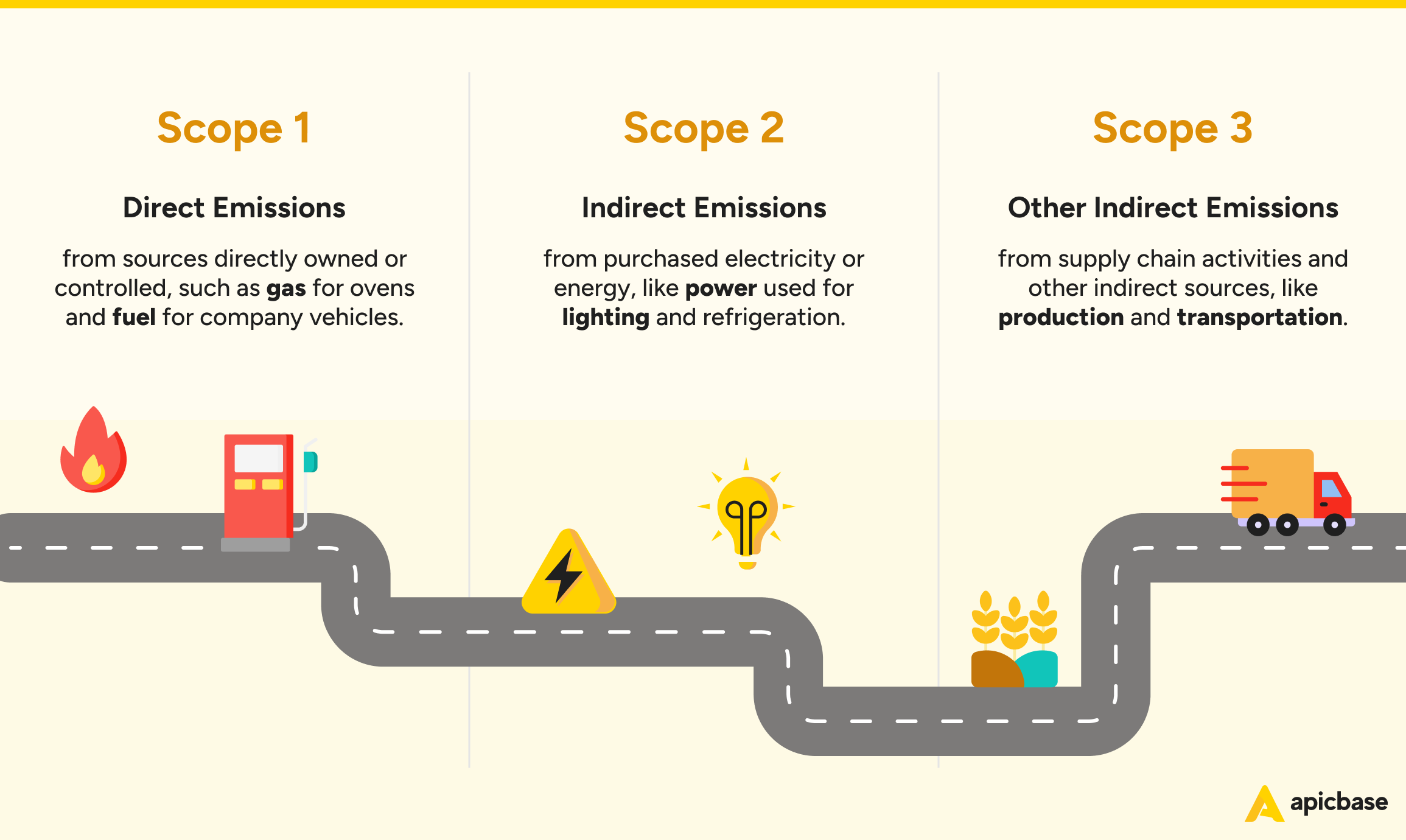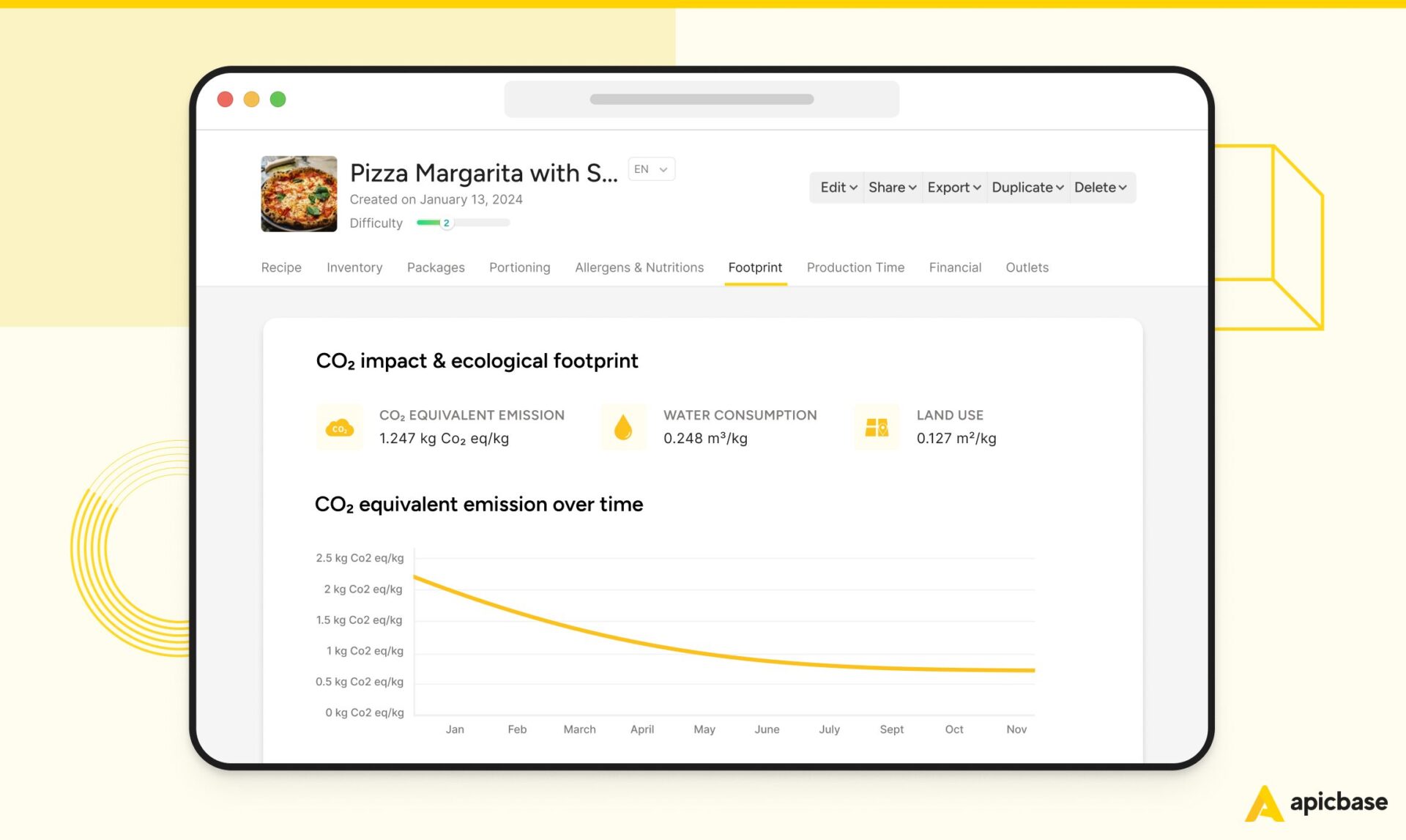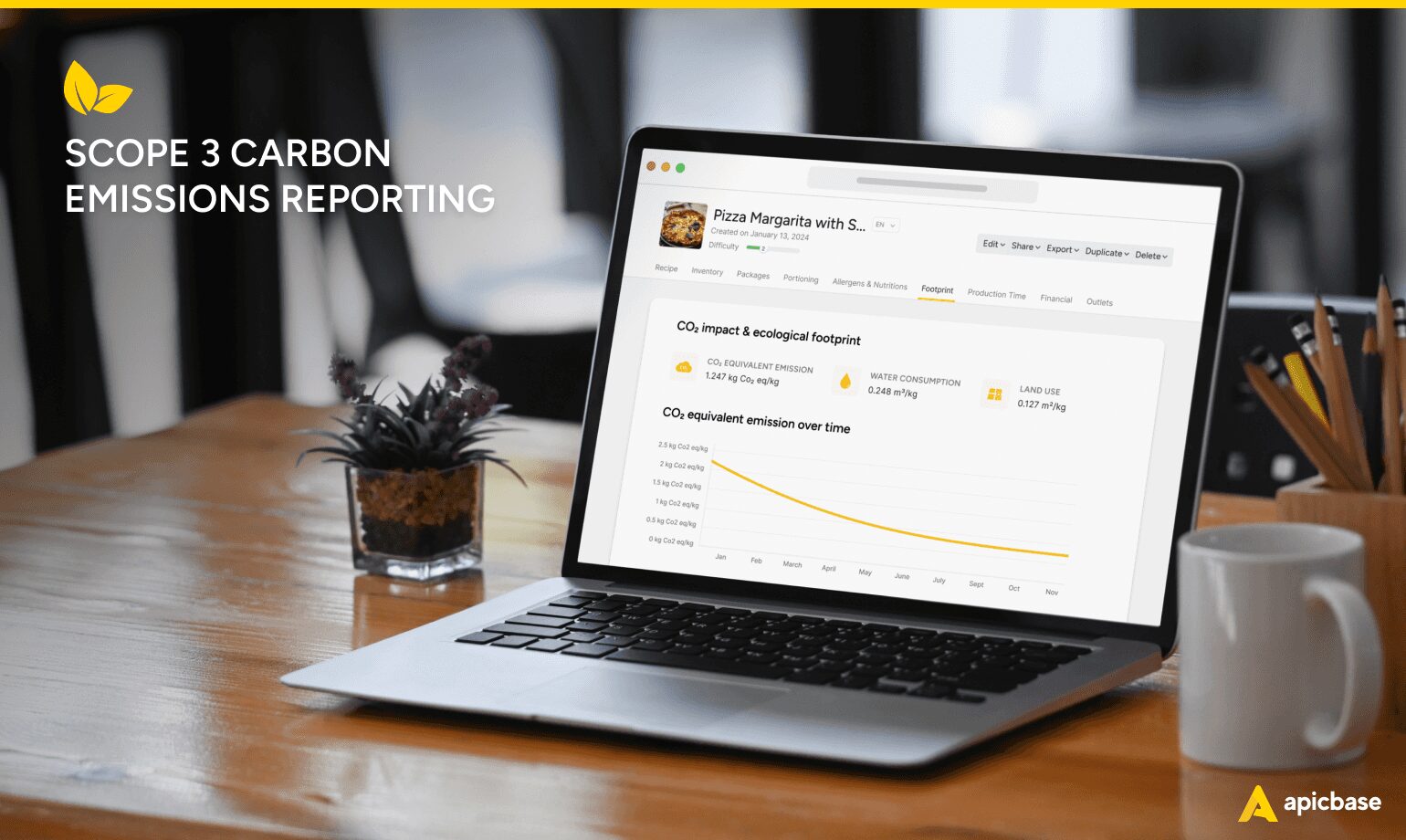The new CSRD regulations require large food service companies to report on Scope 3 emissions, which can be difficult to manage.
Scope 3 emissions come from areas outside your direct operations, like your suppliers and logistics, yet they account for about 70% of your restaurant’s total carbon footprint. Tracking them is tough, but it’s essential for compliance. Ignoring these regulations could lead to severe fines.
It’s not just about avoiding penalties, though. Customers today care increasingly about companies’ environmental and social practices. They want transparency, and this influences where they spend their money.
In fact, in contract catering, it’s now standard practice for institutions and large companies to request ESG (Environmental, Social, and Governance) data when evaluating potential foodservice partners. Caterers who can’t provide this information risk losing out on valuable contracts.
Still, the challenge remains: tracking Scope 3 emissions is difficult. This is where Apicbase can help. Apicbase automates the process of CO2 tracking for your menu, giving you the data you need for accurate carbon reports. This means no more manual tracking, keeping you compliant with CSRD without the hassle.
Using Apicbase, you can turn carbon reporting from a burden into an opportunity, freeing up your time to focus on what matters—running your restaurant smoothly.
Before we explain how Apicbase simplifies your reporting process, let’s examine the challenges of carbon emission tracking and why mastering it is crucial for your business’s future.
What Is Carbon Emission Reporting?

Carbon emission reporting means tracking and sharing all your business’s greenhouse gases (GHGs), including CO2, methane, nitrous oxide, and other climate-impacting gases.
These emissions come from your energy use, transportation, and daily operations. The reports give you a clearer view of your company’s environmental impact and are a key step toward sustainability.
This type of reporting is required under the Corporate Sustainability Reporting Directive (CSRD), an EU law that standardises sustainability reporting for businesses in the EU. The CSRD replaces the old Non-Financial Reporting Directive (NFRD) and has stricter rules about which companies must report and what information they must include.
Who Must Report on Carbon Emissions?
Under the Corporate Sustainability Reporting Directive (CSRD), food service companies in the EU must report their carbon emissions if they meet specific criteria. This includes companies with over 250 employees or exceeding financial thresholds of €40 million in turnover or €20 million in total assets.
The directive applies to any company that meets at least two of the following:
- More than 250 employees
- Over €40 million in turnover
- More than €20 million in total assets
It also affects all publicly listed companies in EU-regulated markets, excluding micro-enterprises. So, even if a company doesn’t meet the size or financial criteria, it must comply if it’s publicly listed.
Non-EU companies with significant operations in the EU are also subject to CSRD. If they generate over €150 million in net turnover within the EU and have at least one subsidiary or branch in the region, they must meet the same reporting requirements.
Why CSRD Changes the Game
The EU’s Corporate Sustainability Reporting Directive (CSRD) reforms how companies report on their environmental impact, which aligns with the Paris Agreement‘s goals to combat climate change. The aim is to create more transparency, level the playing field and encourage companies to adopt greener practices to help create a more sustainable economy.
The CSRD focuses on improving the quality, consistency, and comparability of sustainability reports. This means investors, consumers, and other stakeholders will have access to better, more reliable ESG (Environmental, Social, and Governance) data, allowing them to make informed decisions about a company’s actual environmental performance.
This is important because, beyond compliance, it is a clear business benefit. Investors and stakeholders increasingly value robust sustainability efforts, knowing long-term success depends on them. Accurate ESG reporting can help companies lower risks, make smarter decisions, and better prepare for future challenges.
UK Carbon Reporting: SECR Framework
In the UK, carbon reporting falls under the Streamlined Energy and Carbon Reporting (SECR) framework. Unlike the broader EU CSRD, which covers a wide range of ESG factors, SECR focuses specifically on energy use and carbon emissions, particularly Scope 1 and 2. Reporting on Scope 3 emissions, which covers indirect emissions from supply chains and other activities, is optional under SECR.
CSRD Deadline: When Is Your First Carbon Footprint Report Due?
Companies must start following the CSRD requirements in 2024, with the first carbon footprint reports due in 2025. To stay informed on key dates and affected companies, you can refer to Deloitte’s detailed CSRD timeline.
Carbon Reporting: Scope 1, 2, and 3 Emissions Explained

Under the CSRD, European companies must report on Environmental, Social, and Governance (ESG) topics, with a key focus on greenhouse gas (GHG) emissions. CO2 is the most significant contributor, but other gases like methane and nitrous oxide are also included.
GHG emissions are divided into three categories or scopes. The scopes are based on carbon sources and the level of control a company has over the source. It helps businesses identify where their emissions come from and what needs to be reported.
Scope 1: Direct Emissions
Scope 1 covers emissions from sources your business owns or directly controls. This includes the gas used in your kitchen’s ovens or fuel for company-owned delivery trucks. You can directly act on these emissions by reducing usage or switching to cleaner alternatives.
Scope 2: Indirect Emissions from Energy You Buy
Scope 2 includes emissions from the electricity or energy you purchase to power your operations. Even though your business doesn’t burn fuel to generate this energy, using electricity for refrigerators or lighting still adds to your carbon footprint.
Scope 3: Other Indirect Emissions (Supply Chain & More)
Scope 3 is the largest and most complex category, covering all other indirect emissions in your supply chain or through business activities not directly under your control. These include emissions from food production, packaging, transportation, waste disposal, and employee commuting.
For example, if you buy vegetables from a farm, the emissions from growing, packaging, and transporting those vegetables to your restaurant fall under Scope 3. Tracking this is challenging but crucial for getting a complete picture of your environmental impact.
How to Acquire Scope 3 Carbon Data in Foodservice

Tracking Scope 3 emissions is essential for reducing your environmental footprint and staying compliant with reporting standards. While gathering accurate data across the entire supply chain is challenging, the right strategy and tools make it manageable.
Here are key data sources to focus on, along with tools that can help streamline the process:
- Supply chain emissions: Request carbon footprint data from suppliers or use industry averages.
- Transportation: Obtain emission data from logistics partners or estimate using the distance travelled.
- Waste management: Collaborate with waste disposal companies to track waste types and amounts.
- Employee commuting: Conduct surveys on commuting methods and distances.
Tools to help:
- Apicbase: The platform tracks your carbon footprint and food waste and integrates seamlessly with your procurement and recipe development processes. It eliminates manual data entry errors and offers a complete view of your sustainability metrics.
- Carbon footprint calculators: Online tools or software for calculating transportation emissions.
- Supplier sustainability platforms: Platforms like PS in Foodservice that calculate the carbon footprints of products and packaging.
Why Choose Apicbase Over Stand-alone Solutions?
Tracking Scope 3 emissions is challenging due to the indirect nature of the activities involved. Many carbon reporting solutions add complexity. They require manual exports from external and internal sources and often fail to integrate smoothly with your current systems.
With Apicbase’s carbon footprint tracking software, everything is integrated. There’s no need to juggle multiple systems. Your carbon emissions data is automatically updated every time a restaurant or the central production kitchen places an order with a supplier.
Here’s why Apicbase stands out:
- Integrated Solution: Unlike standalone tools, Apicbase seamlessly integrates with your existing procurement and recipe systems. Your carbon emissions data updates automatically whenever an order is placed, ensuring real-time tracking.
- Comprehensive Tracking: Easily monitor carbon footprints across all locations and central production units (CPUs) without juggling multiple platforms.
- Ingredient and Recipe Insights: Apicbase identifies high-impact ingredients and recipes, allowing you to make informed decisions to reduce your carbon footprint.
- Low-Carbon Menu Engineering: Easily design and implement low-carbon menus, directly influencing procurement and recipe development.
- Customer Transparency: Display carbon footprints on your online menus and ordering apps to show customers your commitment to sustainability.
- Progress Visualisation: Clear dashboards provide a comprehensive view of your carbon reduction efforts, keeping your team on track and stakeholders informed.
- Compliance Made Easy: Stay compliant with EU and UK CO2 reporting regulations without additional administrative burden.
Bonus: Apicbase goes beyond carbon reporting. It also tracks food waste, water consumption, and land use, helping you reduce your restaurant’s overall environmental impact and move toward a more sustainable future.
By choosing Apicbase, you get an all-in-one solution that simplifies sustainability efforts. It makes reducing emissions easy and enhances your business’s eco-friendly initiatives.
Make Compliance and Carbon Reporting Easy

Running a foodservice business means juggling countless tasks, from managing inventory to ensuring compliance, all while trying to reduce your carbon footprint. It’s easy for things to slip through the cracks; before you know it, you’re drowning in paperwork and chasing down errors.
That’s where Apicbase comes in—a powerful back-of-house management software built specifically for multi-unit restaurants, contract caterers, and hotels.
With Apicbase, time-consuming, error-prone tasks—like carbon reporting, stocktaking, and cost calculations—become seamless, automated workflows.

Let Apicbase handle the complexities of carbon reporting, freeing you to focus on delivering exceptional customer experiences and driving your business forward.
Reach out today to see how Apicbase can simplify your ESG reporting.




